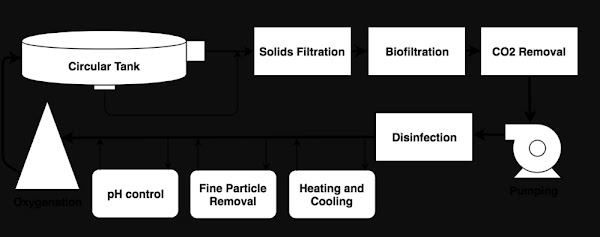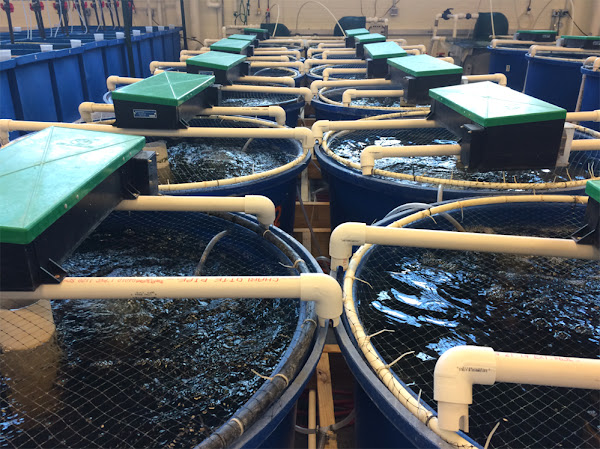Recirculating aquaculture systems or RAS fish farming methods are used in home aquarium. And the RAS fish farming systems are also used for fish production where water exchange is limited and the use of biofiltration is required for reducing toxicity. Other types of environmental control and filtration are often also necessary for maintaining clean water and for providing a suitable habitat for the fish.
The main advantage of RAS fish farming system is the ability to reduce the need for fresh and clean water while still maintaining a healthy environment for fish. The RAS fish farming system must have high fish stocking densities to be operated economically and commercially.
And many researchers are currently conducting studies for determining if RAS fish farming is a viable form of intensive aquaculture. Currently, aquaculture is one of the fastest growing sectors in agriculture because of the growing demand for protein-rich food. And farming fish commercially can be a great way for earning some extra cash. And RAS fish farming system can be a very good way for earning some extras.
How to start RAS fish farming?
Starting RAS fish farming is pretty easy if you follow every step very carefully. Here we are describing more about starting RAS fish farming system.
RAS fish farming system design
The main system has a simple design which consists of fish tanks, mechanical filter, biofilter, trickling filter or degrasser, oxygen enrichment unit and UV disinfector.
You also need some extra facilities such as pH regulator, heat exchange unit, denitrification unit etc.

The basic operating principle of these systems is that the water from the fish tank moves through the mechanical filter and then through biological filter (the water is stripped of carbon dioxide before getting aerated and is returned back to the fish tanks).
Required tank size for RAS fish farming
The tanks used for RAS fish farming system can be of any size and shape. The tank can be rectangular, circular, oval etc.
Mostly the circular or oval tanks are preferred for RAS fish farming system, because they are easier to clean and also facilitate easy water circulation when compared to rectangular tanks.
Size of the tanks can vary from 500 gallons to 500k gallons depending on the available facilities.
The capacity of the tank depends on the factors like type of fish, stocking rate, water requirement and quality. The materials which are used for making the tanks can be wood, glass, rubber, metal, concrete or plastic.
Today, most of the modern tanks are being constructed with outlets that have optimal waste removal capacity and are fitted with suitable mesh screens.
These outlets should also make removal of dead fish easy. Raceway tanks are also used which is a blend of circular and rectangular shapes. These tanks have a wall in the center for faciliating circulation.
Flow of water and pumps
There should be a constant flow of water in RAS fish farming system, and there should be a possibility to alter the speed, pressure and direction depending on the requirement.
Generally the movement of water is controlled through gravitation and before it is used in the system, the water is generally pumped to an elevation from where it begins to flow.
Generally the centrifugal pump is most commonly used in the RAS fish farming system. Usually the pump is placed outside the tank and operates at a high pressure.
Mechanical filters
Mechanical filters are required for removing the waste from the fish tank. Currently, modern recirculating systems have an outlet with a filter called the micro screen of mesh size 40 to 100 microns.
The presence of the micro screen has some advantages such as it reduces the load on biofilter, removes the organic impurities and improves or facilitates the biofiltration process.
Biofilters
Biofilters are the most important component of RAS fish farming system, because it helps in removing the fine pollutants from water during waste treatment.
The biofilters are generally made up of materials like plastic sheets, beads, gravel, sand and lava rock.
A simple biofilter can be a wheel, barrel or box filled with media on which nitrifying bacteria grow.
It can be made of plastic, grass, metal, wood or concrete. And the size of the biofilter defines the fish caring capacity of the entire system.
Biofiltration can be done effectively only if the temperature and pH level of the water are regulated properly.
The minimum temperature of the water should be between 10°C and 35°C, and the pH range should be between 7 and 8. Low and high pH level may result in inefficiency of the filter and higher toxic effect respectively.
Sump for waste collection
The presence of waste in the tank decreases the amount of dissolved oxygen content in water and increases the demand for oxygen (thereby lowering the density of fish in the tank).
So a sump or a clarifier tank is used for collecting the excess waste at a slow rate. The shape of the sump should be of V shape so as to facilitate easy cleaning.
Degrassing
Accumulated gases in the fish tank should be cleared by providing proper aeration. And this method is called stripping.
Supplying air into the tanks can drive the gases away through turbulence. And a trickling filter system is often used for this process.
Aeration or Oxygenation
Providing oxygen supply to the water in the tanks is called aeration. Cool and warm water recirculating systems need 6 and 8 ppm oxygen respectively for bacteria and fish to survive.
The tanks which have high load carrying capacity should be able to replace oxygen every 20 to 30 minutes.
So there should be a proper and regular supply of oxygen otherwise it could lead to loss of fish and also there should be a back up.
Blowing air through a submerged air stone is the commonly used method for aerating the tank. If you can provide sufficient aeration, then there is no need for a distinct carbon dioxide stripping unit.
Types of Wastes
The solid wastes present in the tank can be divided into 3 types. Here we are describing more about these 3 types and also their removal methods.
Ammonia and nitrate toxins
- Ammonia and nitrate toxins occur in two forms; ionized ammonium and free ammonia.
- Can cause brown blood disease in the fish.
- Sometimes also present in the form of ammonia nitrate.
- Nitrate concentration should be below 0.5 mg/l.
- Can be prevented by adding 1 pound of salt to 120 gallons of water.
Settleable waste
- Removed into a sump.
- Can also be removed by suspending them in an exterior settling tank.
- Some waste can be removed from the surface depending on the flow rate.
- Modern way of removal is ECo-TRAPTM which uses a plate at the bottom of the tank to separate the wastes.
Suspended and dissolved wastes
- Requires screen filters or media filters for removing wastes.
- Foam fractionation, rotating microscreens, biofiltration, moving bed filters and floating bed filters are some methods for removing wastes.
Nitrification
The process of detoxifying ammonia is called nitrification. Converting ammonia nitrogen to less toxic nitrogen dioxide and finally to non-toxic nitrate through bacterial action is the principal of nitrification.
De-nitrification
The end production of nitrification process is nitrate and is non-toxic in nature, but the presence of nitrate beyond 100 mg/l has a negative impact on the growth of the fish and feed conversion.
Supplying fresh water regularly to the tank can keep the levels of nitrate low. But the main aim of recirculating system is to maintain or lower the water consumption rate. Therefore a process called de-nitrification is adopted.

The de-nitrification process is required if the supply of water is less than 300 litters per kg of feed.
The minimum amount of methanol required for de-nitrification is 1 kg of nitrogen is about 2.5 kg. The de-nitrifying chamber is fitted to the biofilter with residence time of 2 to 4 hours.
Balancing pH
The pH level of the water should be maintained to a balanced ratio for ensuring the fish to survive well. The tolerable range or limit of the pH level is between 6 and 9.5.
pH of the RAS fish farming system can be maintained by adding buffers like sodium bicarbonate and calcium bicarbonate.
Feeding the fish
You should provide feed in accordance to the growth, body weight and activity of your fish. On average you should feed your fish with 4%-5% food daily of their total body weight.
For example, if the total body weight of the fishes is 100 kg, then you should provide your fish with 4 to 5 kg foods daily. Provide the feeds twice a day.
2-2.5 kg at morning and another 2-2.5 kg during evening. Always try to feed your fish with high quality feeds. You can also purchase the ready-made commercial fish feeds.
What types of fish are suitable for RAS fish farming?
Recycled water is much warmer than natural water. And cold water fish species such as salmon are not good for RAS fish farming system.
Barramundi, carp fishes, perch, catfish, pangasius, white fish, tilapia, blue fin tuna, rainbow trout, seabass and sturgeion are very good for RAS fish farming system.
Stocking density
It is important to keep the production of fish in line with the capacity of the RAS fish farming system. Many methods are used for avoiding overloading of the system with heavy stocking density. Some of the methods are mentioned here;
- The fingerlings are not grown to market size fish in the same tank. Instead you should use separate tanks.
- The fishes grown to an intermediate size are graded and moved to another tank.
- Before introducing the fingerlings into growth system tanks, quarantine tanks are used for them. Both quarantine and growth tanks are physically isolated.
Monitoring and controlling
Fish farming can be properly done only if there is a regulated control and monitoring system within the RAS fish farming system.
A central system for controlling and monitoring of certain features like oxygen levels, pH range, water levels and other functions is deployed for efficient handling of the system.
You can install and use automatic sensors or alarms for indicating when a problem arises.
These are the common RAS fish farming systems. If you don’t have enough space for making earthen or natural pond, then you can try this system for fish farming. Good luck and may God bless you!






